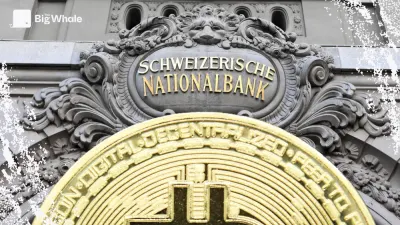TBW - How the payment giants are getting to grips with cryptos

They are still barely visible in our daily lives, but their impact is already being felt on a global scale. Stablecoins, digital assets backed by traditional currencies, are quietly but surely making their way into the world of payments.
Boosted by their promise of immediacy, low cost and transparency, they are attracting the attention of businesses, institutions and, above all, the historic payment giants. The latter, aware of the stakes, are vying with each other in initiatives to position themselves in this new ecosystem.
In 2020, stablecoins represented barely $10 billion in circulation. Today, their capitalisation exceeds $200 billion, an all-time record.
By way of comparison, the volume of stablecoin transactions on the Ethereum blockchain reached $4800 billion in the first half of 2024, even surpassing PayPal's annual volumes. This rise is partly explained by their ability to offer the stability of traditional currencies with the advantages of blockchain.
"Today, more than half of the transaction volumes we process come from stablecoins," explains Varun Paul, director of financial markets infrastructure at Fireblocks, a company specialising in institutional wallets.
These figures illustrate a strong trend: stablecoins are no longer confined to crypto-native uses such as trading or decentralised finance (DeFi). They are now establishing themselves as a viable solution for cross-border payments, cash management and even financial inclusion in emerging countries.
Their success is also based on a successful business model. Stablecoin issuers, such as Tether (USDT) and Circle (USDC or EURC), invest their reserves in government bonds, generating stable returns.
For example, Tether posted a net profit of $2.5 billion in the third quarter of 2024, while Circle, which is preparing for an IPO, reported sales of $779 million in the first quarter of 2023.
According to Jeremy Allaire, CEO of Circle, this economic stability is reinforced by regulatory advances, particularly in Europe: "With the MiCA regulation, stablecoins become legal digital currencies circulating on blockchain. This is a giant step forward for the entire industry."
Read also - Stablecoins 2024 report: an ever-richer ecosystem
Visa, Mastercard, PayPal and Stripe: strategic adoption of stablecoins
Visa has rapidly positioned itself as a key player in the integration of stablecoins. With its global network of 100 million merchants, the giant is facilitating their adoption through strategic collaborations, notably with Gnosis Pay.
The latter offers a payment card backed by stablecoin wallets, allowing users to pay for purchases while remaining connected to the blockchain. Martin Köppelmann, co-founder of Gnosis, says: "Visa offers an unrivalled distribution network, which is essential for coordinating payment flows while complying with local regulations."
Visa is undoubtedly the leader in crypto payment cards. Before Gnosis, the US network had already attracted Coinbase, Cryptocom and Bitpanda. These cards have the advantage of allowing their holders to spend cryptos all over the world without having to go through their bank again: everything is handled by the crypto exchange platforms, thus reducing friction.
For its part, Mastercard is banking on a diversified approach to integrating cryptos into its network. By collaborating with fintechs such as Paxos, the company is facilitating stablecoin payments while exploring new uses such as NFTs to strengthen customer loyalty.
"Stablecoins represent a major revolution. They make payments faster and more accessible, while paving the way for new innovations," Christian Rau, head of digital payments for Mastercard in Europe, tells The Big Whale.
Stripe, meanwhile, reached a milestone in October 2024 by acquiring Bridge, a start-up specialising in stablecoin payments, for $1.1 billion.
This acquisition reflects Stripe's ambition to simplify the use of stablecoins for businesses, while consolidating its role in the digital payments market. "This purchase really validates the impact of stablecoins on the industry and shows that blockchain has become a must-have infrastructure," says Fireblocks' Varun Paul.
PayPal was also one of the first giants to launch its own stablecoin, PYUSD, in the summer of 2023. With an initial capitalisation of $500 million, this stablecoin aims to democratise digital payments for its millions of users.
The company is targeting remittances and international payments in particular, two segments where stablecoins offer a significant advantage in terms of cost and speed.
Read also - How payments specialists integrate digital assets
Various and growing use cases
Stablecoins are not just redefining crypto-native transactions: they are gaining ground in a variety of sectors, becoming an indispensable tool for concrete use cases.
In the area of cross-border payments, they are establishing themselves as an effective alternative to traditional services such as Western Union, where charges can be as high as 6% for an international transfer. "Stablecoins enable near-instantaneous and much cheaper transactions," stresses Varun Paul.
Companies such as Fipto, which raised €15 million in 2023, are exploiting this technology to repatriate funds from international subsidiaries, simplifying financial flows and reducing delays.
In regions such as Africa and Latin America, stablecoins also play a crucial role in financial inclusion by providing direct access to digital dollars, which are often inaccessible via traditional banking systems. In Africa, for example, Yellow Card helps individuals and businesses bypass local currency shortages to make cross-border payments.
For businesses, stablecoins have become an ideal solution for securing assets, reducing conversion costs and generating competitive returns. With rates easily reaching 10% a year, they far outperform traditional savings accounts, attracting a growing number of large companies, particularly in the international trade and tech sectors.
However, despite their success, stablecoins face several obstacles. Regulation remains a major issue. While frameworks such as MiCA offer guarantees in Europe, other regions are still struggling to harmonise their policies, as is the case in the United States.
Also, direct adoption of stablecoins by merchants remains limited. This reality is driving projects to develop decentralised alternatives, capable of competing with traditional networks while relying on blockchain to maximise their potential.
Challengers on the lookout: towards a decentralised infrastructure
Players such as Safe and Aptos are exploring decentralised models to reduce dependence on traditional giants. Safe, for example, is developing Safenet, a network designed to enable payments to be made entirely on-chain.
"Safenet should enable payments to be made via any blockchain to combat the fragmentation caused in particular by the multiplication of layer 2s," explains Lukas Schor, co-founder of Safe. Aptos, meanwhile, is banking on its ability to process billions of transactions a day to attract businesses looking for large-scale solutions.
See also - Lukas Schor (Safe): "We want to create a decentralised equivalent of Visa"
Base, the layer 2 developed by Coinbase, also represents an ambitious initiative. By leveraging its user base of more than 100 million people, Base is promoting the adoption of USDC and EURC, its euro stablecoin, as payment solutions for merchants and businesses.
While stablecoins are already redefining the standards for speed and cost in the payments sector, their true potential is still largely untapped. Beyond their current uses, these assets could tomorrow become the bedrock of a hybrid ecosystem where decentralised infrastructures and traditional networks coexist.
The rise of fully on-chain blockchain solutions, coupled with the efforts of payment giants to modernise their offerings, is paving the way for radical innovations. As these technologies converge, the question is no longer just whether stablecoins will transform the industry, but to what extent they will become its central driver.
In this new era, businesses, regulators and consumers will need to work together to shape a system where technology serves not only efficiency, but also transparency and financial inclusion on a global scale.



